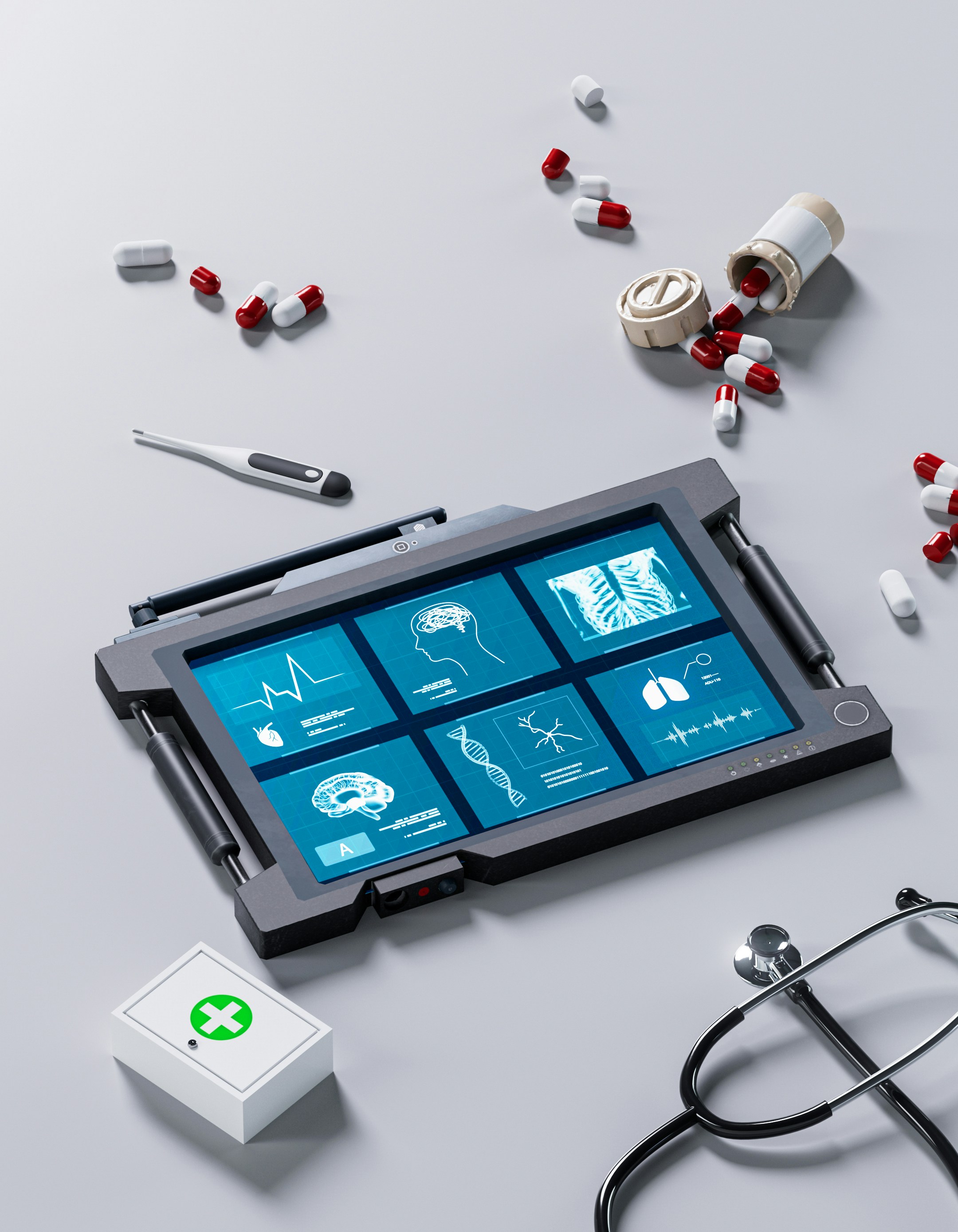AI in Everyday Clinical Practice: Tools for Doctors and Nurses
A practical CME day that introduces medical professionals to artificial intelligence, focusing on how it can improve workflow, support decisions, and safeguard patients.

About this Conference
This program gives doctors, nurses, and other professionals a clear and accessible overview of AI in healthcare. You will learn what AI can realistically do, how it is being used in clinical practice today, ways it can ease documentation and communication, and what safety and ethical guardrails are needed. The focus is on practical, bedside-relevant insights without unnecessary technical jargon.
- 7:00 AM - 11:45 AM
- Schedule (Local Time)
- 16 Workshops
- Number of Subjects
- Online Course
- Course Type
- New York
- Destination
Destination
1-Day Schedule
Conference Outline
- Day 1
A practical CME day that introduces medical professionals to artificial intelligence, focusing on how it can improve workflow, support decisions, and safeguard patients.
- Section 1AI 101 for Clinicians: Foundations, Capabilities, and Limits
An accessible introduction to what AI is, how it works in plain language, and what it can and cannot do in clinical settings.
7:00 AM —8:00 AM60 Minutes
- Describe in plain terms what AI is and how it differs from traditional computer tools.
- Identify realistic examples of AI in healthcare that clinicians may already encounter.
- Recognize the common limits and errors AI can make so clinicians can use it safely.
- 1Understanding the Basics of AI
Introduces AI as 'smart computer programs' and explains how they learn patterns from large sets of medical data.
7:00 AM15 Minutes
- Define AI in straightforward, practical terms.
- Explain how AI systems learn patterns from medical data.
- List at least two differences between AI and traditional computer systems.
ai in healthcareintroductiontechnology basics- 2Where AI is Already Helping in Medicine
Shows current examples of AI in radiology, pathology, and patient monitoring that clinicians may already use.
7:15 AM15 Minutes
- Identify at least three areas where AI is already in use in clinical practice.
- Discuss how AI may improve accuracy in diagnostics.
- Recognize how AI fits into existing workflows rather than replacing clinicians.
clinical decision supportdiagnosticsimaging- 3What AI Can and Cannot Do
Explains AI’s strengths, like spotting patterns quickly, and its weaknesses, such as misreading rare cases.
7:30 AM15 Minutes
- Explain in plain language what AI systems are best at.
- Identify at least two limits of AI in patient care.
- Discuss why clinical judgment is always needed with AI tools.
ai in healthcaresafetyclinical practice- 4Recognizing Errors and Safe Use
Focuses on common mistakes AI tools make and how clinicians can recognize and manage them safely.
7:45 AM15 Minutes
- List at least three common types of AI errors.
- Describe how to double-check AI suggestions before acting.
- Apply at least one safe practice when using AI with patients.
ai in healthcareclinical safetyerror prevention- —Break
Break time.
8:00 AM15 minutes
- Section 2Clinical AI in Practice: Imaging, Diagnostics, and Risk Tools
Real-world examples of how AI supports diagnosis, image reading, and risk scoring in hospitals and clinics.
8:15 AM —9:15 AM60 Minutes
- Identify how AI is used in radiology, cardiology, dermatology, and primary care.
- Evaluate the benefits and limitations of AI decision support tools.
- Recognize the risks of over-relying on AI in diagnostics.
- 5AI in Radiology and Imaging
Looks at AI tools that help read X-rays, CT scans, and MRIs, and how they compare to radiologist performance.
8:15 AM15 Minutes
- Describe how AI supports image interpretation.
- List at least two strengths AI brings to imaging.
- Discuss how radiologists can use AI as an assistant, not a replacement.
imagingradiologyclinical decision support- 6AI in Pathology and Lab Medicine
Explains AI tools that analyze tissue slides and lab data to support faster and more consistent diagnosis.
8:30 AM15 Minutes
- Explain how AI is applied to pathology and lab data.
- Identify benefits such as improved consistency and speed.
- Recognize the need for clinician confirmation of AI results.
pathologydiagnosticsclinical labs- 7Risk Scores and Prediction Tools
Covers tools that predict sepsis, heart disease, or hospital readmission, and how to use them wisely.
8:45 AM15 Minutes
- Describe at least two common risk prediction tools that use AI.
- Identify benefits and pitfalls of relying on predictions.
- Explain how to combine AI risk scores with patient context.
risk stratificationpredictive toolsclinical practice- 8Avoiding Alert Fatigue and Over-Trust
Discusses risks such as too many alerts or clinicians placing too much trust in AI outputs.
9:00 AM15 Minutes
- Explain what alert fatigue is and how AI can contribute.
- List at least two strategies to manage AI alerts.
- Describe why clinical oversight must remain central.
clinical safetyworkflowdecision support- —Break
Break time.
9:15 AM15 minutes
- Section 3AI Scribes and Workflow Automation
Explores how AI can draft notes, sort messages, prepare orders, and assist in communicating with patients.
9:30 AM —10:30 AM60 Minutes
- Describe how AI scribes help with medical note documentation.
- Identify ways AI can support communication with patients.
- Evaluate safe practices for reviewing and editing AI-generated text.
- 9AI Scribes for Documentation
Introduces AI scribes that listen to patient visits and create draft notes for clinicians to edit.
9:30 AM15 Minutes
- Describe how AI scribes record and draft notes.
- Identify at least two benefits of AI scribes for clinicians.
- Explain why editing and clinician approval are essential.
workflow automationdocumentationpatient visits- 10Sorting Inboxes and Drafting Orders
Explains how AI can help manage message inboxes and suggest orders, saving time for busy clinicians.
9:45 AM15 Minutes
- Explain how AI can triage and summarize patient messages.
- Describe how AI can suggest basic orders.
- Recognize why clinicians must review all AI-generated content.
workflowclinical ordersautomation- 11Patient-Friendly Communication
Shows how AI can help clinicians write instructions and messages in language patients understand.
10:00 AM15 Minutes
- Describe how AI can make medical language easier for patients.
- List at least two examples of patient-friendly communication supported by AI.
- Explain how to check AI-written messages for accuracy and clarity.
patient communicationeducationworkflow automation- 12Reviewing and Editing AI Outputs
Focuses on the importance of clinician review, editing, and responsibility when using AI-drafted materials.
10:15 AM15 Minutes
- List at least three risks of using AI-generated text without review.
- Explain how to safely edit and finalize AI outputs.
- Apply best practices for accountability when using AI tools.
workflowdocumentationclinical safety- —Break
Break time.
10:30 AM15 minutes
- Section 4Safety, Ethics, and Governance for Clinical AI
Covers safe and ethical use of AI in patient care, focusing on privacy, fairness, and clinician responsibility.
10:45 AM —11:45 AM60 Minutes
- Identify key ethical and safety concerns when using AI in healthcare.
- Apply strategies to protect patient privacy and confidentiality.
- Evaluate how to responsibly explain AI-assisted care to patients.
- 13Bias and Fairness in AI
Explains how AI can sometimes be less accurate for certain groups of patients and how to check for fairness.
10:45 AM15 Minutes
- Describe what bias in AI means in plain terms.
- Identify at least two examples of how bias can affect patient care.
- Explain one way clinicians can watch for unfair results.
ethicsfairnesspatient safety- 14Patient Privacy and Confidentiality
Reviews rules and best practices for protecting patient data when using AI tools.
11:00 AM15 Minutes
- Explain why patient privacy is at risk when using AI.
- List at least two rules or safeguards for patient data.
- Apply at least one practice to keep PHI secure.
privacyhipaadata security- 15Explaining AI-Assisted Care to Patients
Shows how to talk with patients about AI use in their care in straightforward, reassuring language.
11:15 AM15 Minutes
- Describe how to explain AI in plain language to patients.
- List at least two patient concerns about AI use in care.
- Practice at least one reassuring way to frame AI support.
patient communicationethicsclinical practice- 16Governance and Professional Responsibility
Focuses on clinician responsibility, professional standards, and oversight for AI use in healthcare.
11:30 AM15 Minutes
- Identify key elements of AI oversight in a clinic or hospital.
- Describe clinician responsibilities when AI is used in care.
- Apply at least one policy or checklist item to guide safe use.
professional standardsethicsgovernance- —End of Day
End of program.
11:45 AM
Key Objectives
- Explain the basic concepts of AI in plain terms and describe where it is already used in healthcare.
- Evaluate the benefits and risks of AI tools in common clinical settings, including imaging, diagnostics, and documentation.
- Apply safe practices for using AI in patient care, including communication, documentation, and ethical considerations.
Virtual Conferences
Flexible Destination-Based Learning
549 Destinations Available
Our conferences are delivered entirely online through short, high-impact video sessions. Designed for travelers and professionals on the go, each module is just 15 minutes—so you can complete your learning in the morning and spend the rest of your day enjoying the destination.


Satisfaction Guaranteed
Reschedule or Cancel Anytime
Easily reschedule or apply your credit to another class—no hassle, no stress. If you prefer a refund, we offer a full return minus a $30 processing fee—because we know you value flexibility.
Frequently asked questions
Can’t find the answer you’re looking for? Reach out to our customer support team.
- How does destination-based learning work?
- Destination-based learning is a teaching method that involves students traveling to a specific location to learn about a particular subject. This method allows students to gain a deeper understanding of the subject by experiencing it firsthand.
- Is this conference live?
- Conferences are scheduled and attended at their designated time and locations. Attendees participate from the designated location of the event and experience expert-reviewed content in real-time.
- Is my travel and lodging included?
- Pricing is for the conference itself. Travel and lodging are not included but for some destinations we offer partnership benefits and discounts.
- Can I change the destination or scheduled date later?
- You can easily change the destination or scheduled date for no fee. You can also request a full refund minus a $30 processing fee.
AI in Everyday Clinical Practice: Tools for Doctors and Nurses
1-Day Conference
- 7:00 AM - 11:45 AM
- Schedule (Local Time)
- 16 Workshops
- Number of Subjects
- Online Course
- Course Type
- New York
- Destination